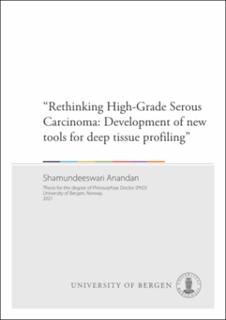| dc.contributor.author | Anandan, Shamundeeswari | |
| dc.date.accessioned | 2021-08-25T11:29:18Z | |
| dc.date.available | 2021-08-25T11:29:18Z | |
| dc.date.issued | 2021-09-03 | |
| dc.date.submitted | 2021-08-12T15:31:16.404Z | |
| dc.identifier | container/b2/6b/48/f2/b26b48f2-00a4-4fa7-934c-61ed9279d78e | |
| dc.identifier.isbn | 9788230858851 | |
| dc.identifier.isbn | 9788230869086 | |
| dc.identifier.uri | https://hdl.handle.net/11250/2771167 | |
| dc.description.abstract | Background: High-grade serous ovarian cancer (HGSOC) is the most frequently occurring and most fatal epithelial ovarian cancer (EOC) subtype. The reciprocal interplay of the different components encompassed within the tumour microenvironment (TME) are fundamental for tumour growth, advancement, and therapy response. It is therefore important to be able to deeply characterize the complex and diverse TME with multidimensional approaches.
Aims: The main aim of this project was to establish novel multiparametric mass cytometry panels and thoroughly characterise the HGSOC TME.
Methods: We first developed a novel 35-marker ovarian TME-based Cytometry by time-of-flight (CyTOF) panel (pan-tumour panel) and utilized it to examine the effects of six different tissue dissociation methods on cell surface antigen expression profiles in HGSOC tumour samples (Paper I). We further established an unique immune panel (pan-immune) for the detailed immunophenotyping of chemo-naïve HGSOC patients. The individual tumour immune microenvironments were characterized with tailored computational analysis (Paper II). With the use of an established merging algorithm— CyTOFmerge—the pan-tumour and pan-immune datasets were merged for a more in- depth immune delineation of the ten ovarian chemo-naïve TME profiles in addition to tumour and stromal cell phenotyping (Paper III).
Results: We have established a novel ovarian TME-based CyTOF panel for HGSOC that is capable of delineating the immune, tumour, and stromal cells of the TME. Utilizing this panel, we demonstrated that, although the six tissue dissociation methods have a certain level of influence on the TME antigen expression profiles, inter-patient differences between the tumour samples are still clear. In addition, we identified a previously undescribed stem-like cell subset (Paper I). We have developed a unique 34-marker immune panel and have provided a detailed characterization of the ovarian tumour immune microenvironment of chemo-naïve patients. We identified a high degree of interpatient immune cell heterogenicity and discovered an abundance of conventional dendritic cells (DC), natural killer (NK) cells, and unassigned hematopoietic cells. Certain monocyte and dendritic cell (DC) clusters have shown prognostic relevance within the ovarian TME (Paper II). The merged dataset analysis revealed a new level of complexity with a more in-depth immune (myeloid cells) delineation in addition to tumour and stromal (fibroblast subsets) cell phenotypes. We identified an even higher degree of interpatient TME heterogenicity and a novel tumour cell metacluster, CD45-CD56-(EpCAM-FOLR1-CD24-). As a benefit of integrating the datasets, we identified even higher clinical associations (from 12 [pan-tumour dataset] to 20 [merged dataset]). Furthermore, most of these observed associations were majorly between PFS, OS, and infiltrating immune cell subsets (Paper III).
Conclusions and consequences: (Paper I) In conclusion, the panel represents a promising profiling tool for the in-depth phenotyping of the HGSOC TME cell subsets. Although the tissue dissociation methods have influence on the TME antigen expression profiles, inter-patient differences are still clear. (Paper II) Our findings revealed a high degree of heterogeneity and identified phenotypic profiles that can be explored for use in HGSOC phenotypic profiling. (Paper III) Together, the merged sketching illustrates that comprehensive individual TME mapping for HGSOC patients can contribute to a better understanding each patient’s unique micromilieu given the need for more personalized treatment approaches. | en_US |
| dc.language.iso | eng | en_US |
| dc.publisher | The University of Bergen | en_US |
| dc.relation.haspart | Paper I. Anandan, S.*; Thomsen, L.C.V. *; Gullaksen, S.-E.; Abdelaal, T.; Kleinmanns, K.; Skavland, J.; Bredholt, G.; Gjertsen, B.T.; McCormack, E.; Bjørge, L. “Phenotypic characterization by mass cytometry of the microenvironment in ovarian cancer and impact of tumour dissociation methods”. Cancers 2021, 13, 755. The article is available in the thesis. The article is also available at: <a href="https://doi.org/10.3390/cancers13040755" target="blank">https://doi.org/10.3390/cancers13040755</a> | en_US |
| dc.relation.haspart | Paper II. Anandan, S.; Kleinmanns, K.; Gullaksen, S.-E.; Iversen, G.A.; Akslen, L.A.; McCormack, E.; Bjørge, L, Thomsen, L.C.V. “The use of high-dimensional single-cell analysis discloses emerging insight to the complexity of the immune tumour microenvironment in treatment naïve high-grade serous ovarian carcinomas”. Not available in BORA. | en_US |
| dc.relation.haspart | Paper III. Anandan, S.; Thomsen, L.C.V.; Kleinmanns, K.; Abdelaal, T.; Gullaksen, S.- E.; Iversen, G.A.; Akslen, L.A.; McCormack, E.; Bjørge, L. “Integration of mass cytometry data with CyTOFmerge reveals the heterogeneous and complex tumour milieu in high-grade serous ovarian carcinomas”. Not available in BORA. | en_US |
| dc.rights | In copyright | |
| dc.rights.uri | http://rightsstatements.org/page/InC/1.0/ | |
| dc.title | “Rethinking High-Grade Serous Carcinoma: Development of new tools for deep tissue profiling” | en_US |
| dc.type | Doctoral thesis | en_US |
| dc.date.updated | 2021-08-12T15:31:16.404Z | |
| dc.rights.holder | Copyright the Author. All rights reserved | en_US |
| dc.description.degree | Doktorgradsavhandling | |
| fs.unitcode | 13-25-0 | |
